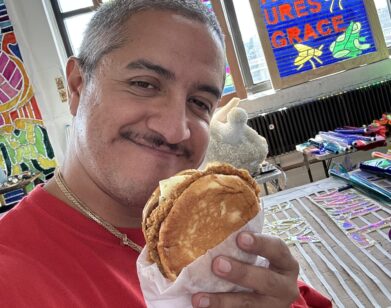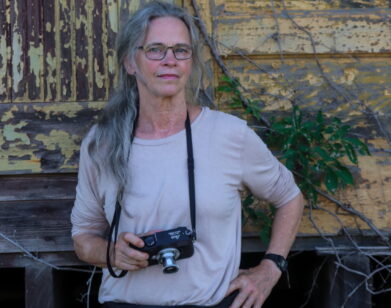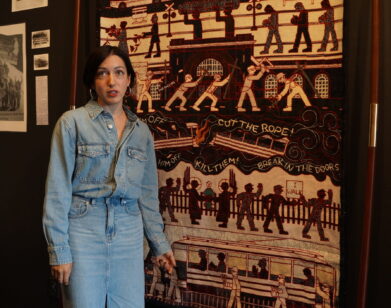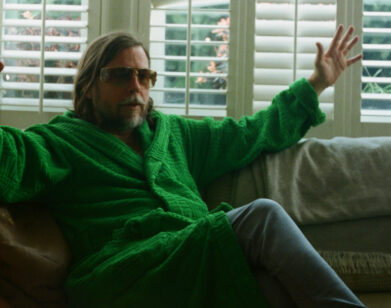Back From the Edge: Max Snow Photographs His Life, Not the KKK
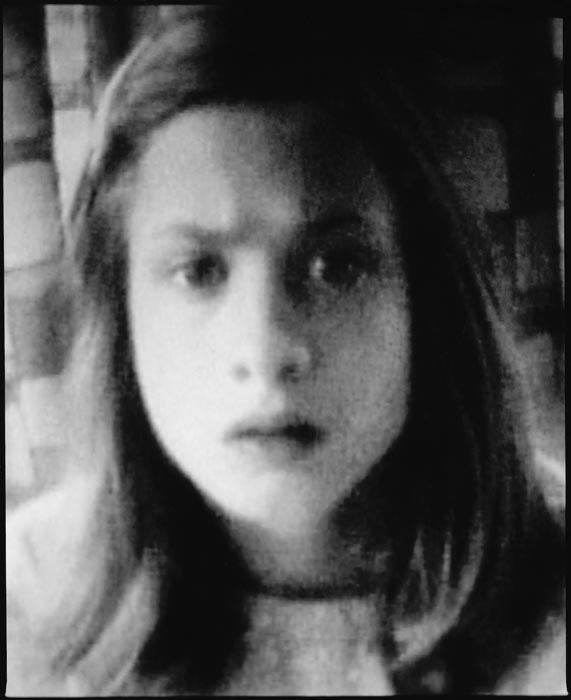
PHOTOS BY COLIN DODGSON
Curator Karline Moeller and artist Max Snow are cousins through marriages that have dissolved—but the bonds between them are deeper than that. In 2008, they opened a gallery together, and Moeller had a hand in Snow’s second exhibition, at Paul Johnson Trading in New York. Jesus Is Showing Me Amazing Things features Snow’s black-and-white photographs, intimate and melancholic moments from a rough year in the artist’s life. In various levels of crispness but with straight-on composition, Snow memorializes the sacred and the abused alike. Here artist and curator discuss the bonds that kept Snow from making another series of documentary photographs, and how Moeller helps him set things on fire.
KARLINE MOELLER: Your last solo show in New York opened two years ago and featured three separate series of documentary portraits: Latin gang members from downtown Los Angeles, black metal bands from Scandinavia, and members of Ku Klux Klan groups from Indiana and Kentucky. In the interim, you took a break from showing your work while we opened our gallery [Moeller Snow, in New York]. This time around, you’ve set up the shows, and the results are entirely yours. They don’t belong to any anthropology. How do you think your work has changed since in the two years?
MAX SNOW: This show was a departure from the more journalistic approach that I’d previously taken. Due to extenuating circumstances I was unable to leave the city and my typical environment; I was forced to stick around, not disappear, and be more introspective. I really had to feel what was going on in my life. So, it’s much more personal, this body of work. LEFT: UNTITLED (COFFIN), 2010. COURTESY THE ARTIST.
PHOTO BY COLIN DODGSON
MOELLER: You’re used to long, immersive trips leading up to your photographs. Did you undergo an analogous process of immersion here?
SNOW: Past projects were sometimes exhausting, even emotionally more than physically. Spending time with the KKK, for example, and listening to their rhetoric would leave me depleted. These new images are pictures from my mind, things that occurred in my dreams and in my waking life. The past year has been such a blur, it’s hard to know what was real and what wasn’t. I don’t remember much of the past year. It was scary for me to recreate these images but somehow I had to. Someone was showing me these things, and it might be tempting fate, but I had to bring them forth.
MOELLER: There are four photographs in this show where large objects–a pentagram, a rune, a ship, and a skeleton–have been set ablaze. They do have formal similarities to some of your earlier, documentary images. LEFT: PHOTO BY COLIN DODGSON
SNOW: The first time I saw lit symbols was at a Klan gathering in Kentucky. There was a cross and a swastika, which were set aflame. For such negative symbology, the ritual was actually strangely sensitive at the beginning. As they set fire to the images, they said a prayer, and everyone was silent. Of course it degenerated into a wild hoo-ha shortly thereafter. They take great exception to differentiate between burning and lighting, as it is meant as a testimonial, whereas burning is most often something done in spite. I was honoring these symbols that had power to me. The burning ship is different. To me it signifies broken dreams.
MOELLER: And what about the title of the show, “Jesus Is Showing Me Amazing Things?”
SNOW: When I was 12 my great-grandmother died and those were some of her last words. We were all around her deathbed in Houston, we were drinking sherry—she was drinking, too; she had a stick with a sponge on the end that she would dip in the glass and then put the sponge in her mouth. I was allowed a glass also.
MOELLER: When you were 12.
SNOW: I started drinking way before that, so it wasn’t a big deal. But one of the last things she said that day was, “Don’t be afraid for me, because I’m not afraid. Jesus is showing me amazing things.” She was deeply religious. I don’t know if I can say the same for myself, which makes the title a little bit ironic. I’ve always felt like a heretic in some form or another. I was the only one of my siblings who wasn’t baptized.
MOELLER: Although much of the work in this show is dark and heavy, there are also quite a few comical pieces.
SNOW: Well it hasn’t changed, has it? It’s still pretty dark. I never intend for it to be that way, but I’m not at a point where I am able to photograph flowers and puppies. I guess, for me, it’s always been that the things that are inherently beautiful don’t have lasting power as much as the things you have to spend time with in order to appreciate. I’d like to photograph more naked women, but I think they’re scared to pose for me, that I might light them on fire, or something like that.
MOELLER: One of your strongest talents is that you confront the viewer with images that they probably wouldn’t see elsewhere. I find that is the beauty of it. When you’re creating scenarios that you’re photographing, do you have a measure of confrontation in mind?
SNOW: Not so much. I never really mean to shock people, I don’t dig the whole shock value thing. These are images that I’ve conjured from somewhere that have plagued me or visited me in dreams, or recurred in my mind, and it’s less to shock, but more to say, “Welcome to my world for a moment.” I find it funny when people are freaked out by my work. People often don’t like looking at the macabre, which is strange because I think most people are walking dead, zombies. They just don’t know it. Walk through SoHo on a weekend and you’ll see what I mean. LEFT: GENIE, 2009. COURTESY THE ARTIST
MOELLER: There is an urn in the show with your name on it and it is sealed with black wax. What’s inside?
SNOW: In the fall of 2009 I burnt most of my archives. Prints, negatives, almost everything with the exception of a few images that had sentimental value. I guess I pulled a Baldessari. I needed to start over in many ways.
MOELLER: There’s one image in the show titled Genie, it’s a striking image of a young girl. Can you tell me about her?
SNOW: Genie was a girl who was discovered in Los Angeles, when I believe she was 13, they learned that from infancy she had been strapped to a potty chair in her bedroom and forbidden to make noise by her parents. She was mentally disabled. They tried to figure out was whether she was since birth or if she had been damaged by her experience. I thought she looked beautiful in that moment of stock footage. But I relate to her. I often felt that wolves, in a way, raised me.
JESUS IS SHOWING ME AMAZING THINGS IS ON VIEW BY APPOINTMENT THROUGH MAY 31. PAUL JOHNSON IS LOCATED AT 191 CHRYSTIE, SIXTH FLOOR. CONTACT [email protected] OR [email protected] FOR AN APPOINTMENT.


